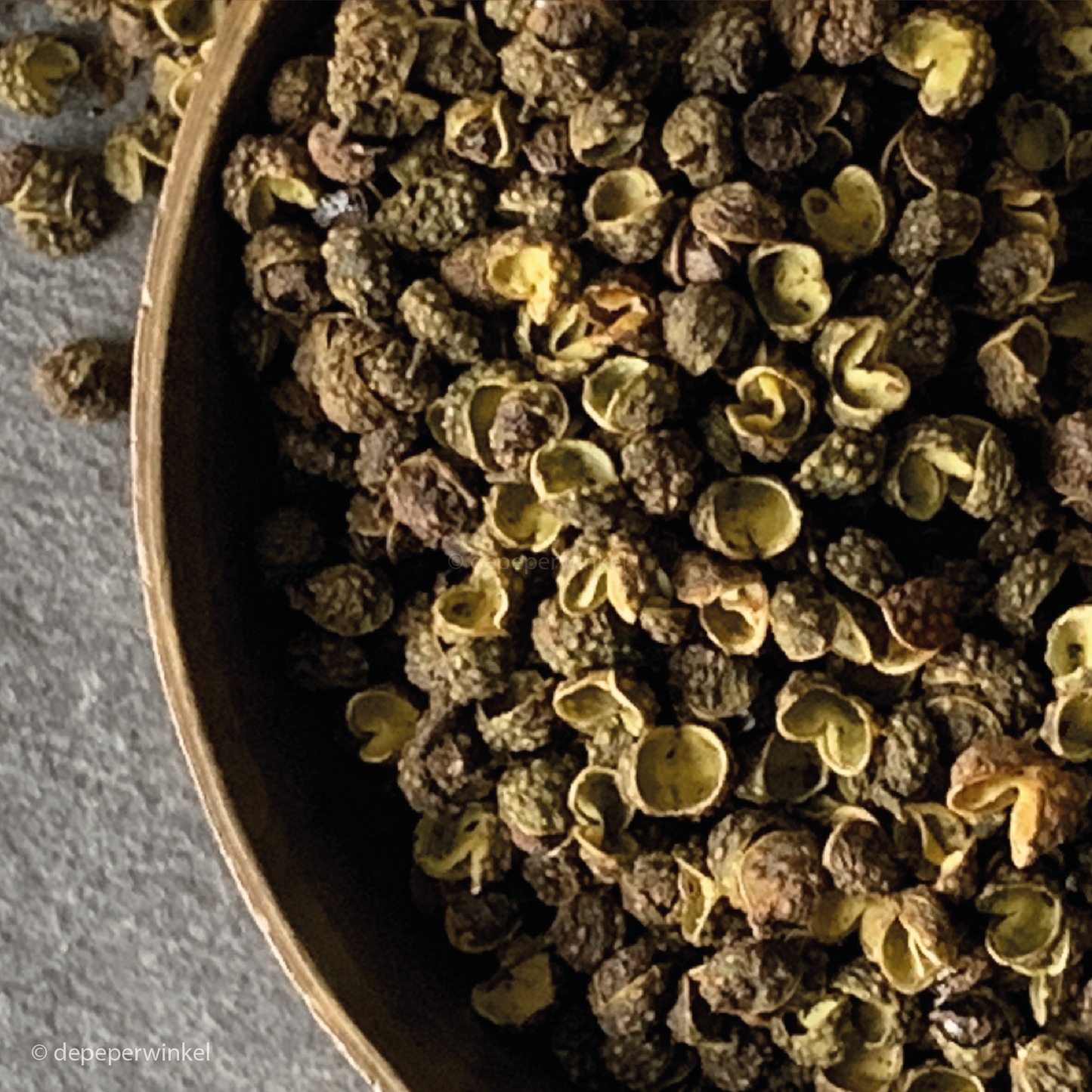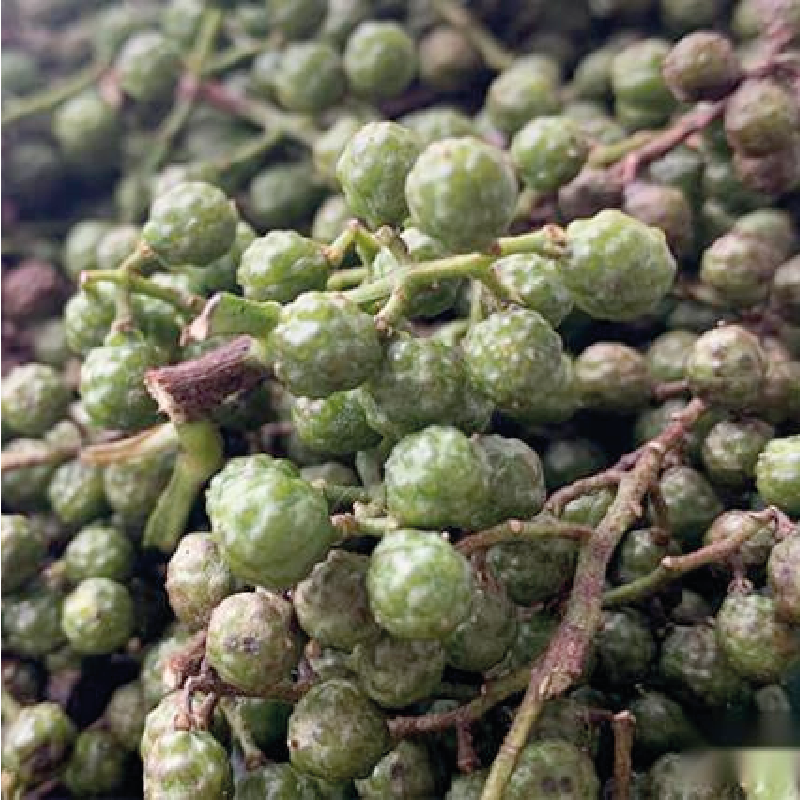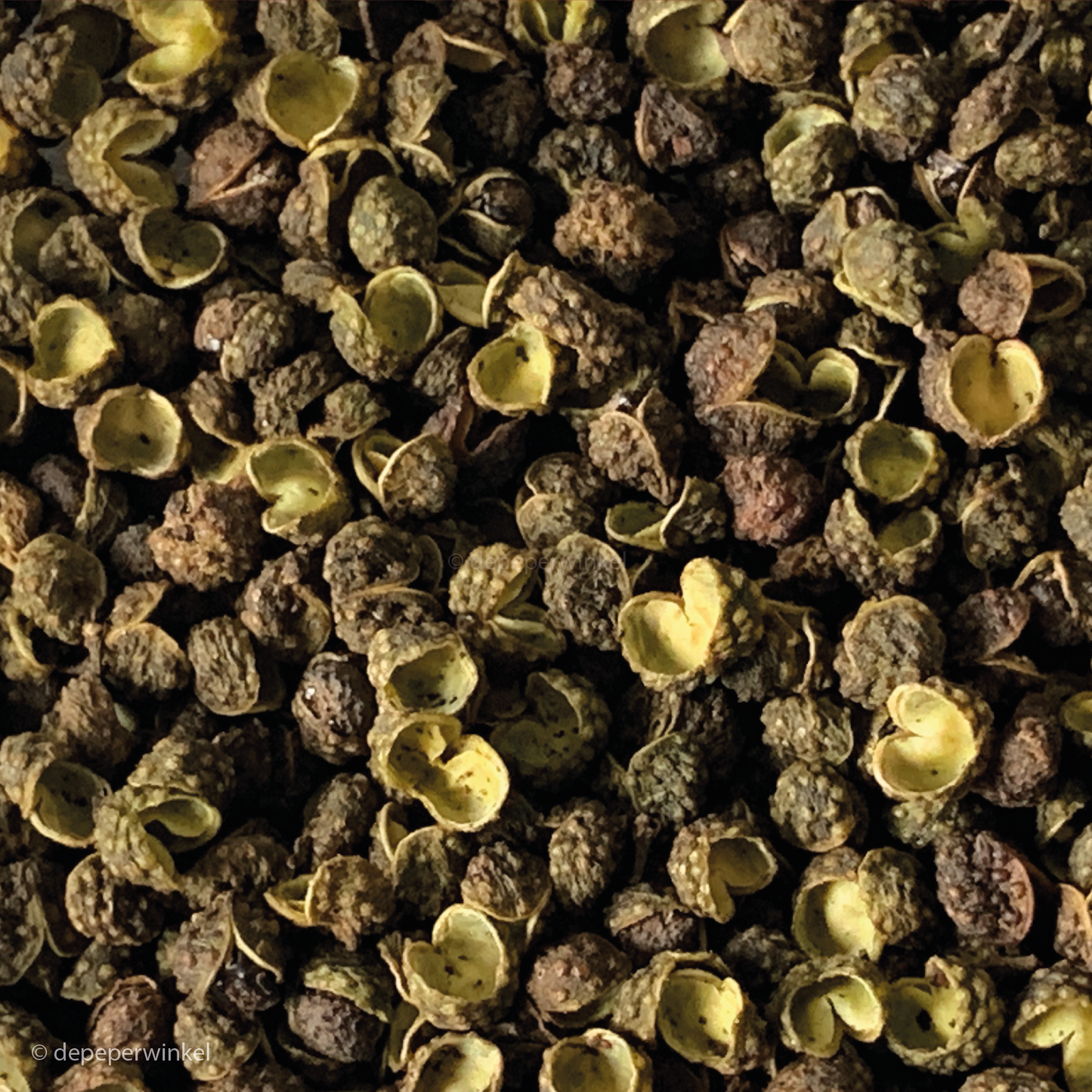depeperwinkel
Green Szechuan pepper Qīng huā jiāo
Green Szechuan pepper Qīng huā jiāo
Unable to load availability for pickup
This green huā jiāo. in full Qīng huā jiāo, is a special Szechuan pepper. It is characterized by a fresh lemon aroma, which combines well with fish, chicken and vegetables. It is mainly used in hotpot and noodle dishes.
This Sichuan pepper is the dried, unripe berry of the Zanthoxylum bungeanum, one of the many species of toothpine tree, called prickley ash in English, because of the enormous spines on the trunk and branches. The pepper is called Szechuan pepper after the region where it naturally grows, Szechuan, home to one of the ten classic Chinese cuisines. The berry is larger than that of Zanthoxylum piperatum.
The Zanthoxylum is a plant that can grow into a large tree whose bark is covered with coarse, sometimes lignified spines. The bark therefore appears to be covered with a row of 'molars', hence the Dutch name toothache tree. In traditional Chinese medicine, the peppers and the root are used - not surprising given the appearance of the tree - to combat toothache.
The green berry is picked early in the autumn, well before the berries open and the rather bitter seeds are released. The berries are traditionally dried in the sun. The better quality Sichuan pepper - such as this one - contains no or hardly any seeds and no or hardly any stems, and is dried conditioned with air (air dried -AD).
There is a clear taste difference between the larger berry of the Zanthoxylum bungeanum and the smaller average berry of the Zanthoxylum piperitum, which makes the former very popular with Asian chefs. The small and often darker berry is the most sought after on the Chinese consumer market, but also in other Asian countries (and Europe), partly because of the generally lower price. The 'old guard' in China also clings to the taste of this commonly available Sichuan pepper, but with a preference for the unripe, green one.
The unique sharpness experience of sanshol
Characteristic of all Zanthoxylum peppers, and therefore also of this Szechuan pepper, is the tingling you experience on the tip of your tongue due to a substance in the pepper called sanshool, named after the Japanese sanshō. The pungency is caused by the amides in the peel of the fruit: α-, β-, γ- and δ-sanshool, α hidroxy sanshool and β-hidroxy sanshool. γ sanshool and α hidroxy sanshool are mainly responsible for the anesthetic effect. The amount of α-hidroxy-sanshool in the berries can amount to (more than) 50 ‰ of the dry weight, of γ sanshool around 5 ‰.
Szechuan is known as the sharpest Zanthoxylum pepper. The Indonesian andaliman - a fairly rare variety - is conveniently forgotten, because this 'Batak pepper' is also quite sharp. By the way, ripened berries are sharper than the unripe ones.
The tingling is accompanied by a slight numbness, jokingly compared to tasting a 9 volt battery. One single berry is enough to experience that! This somatosensation, stimulation by touch, has been used as an anesthetic in traditional medicine in Asia for centuries. The effect is very complex and the subject of extensive studies. Hydroxy-α-sanshol in particular is said to cause the tingling, and there are certain parallels with the pungency sensation of capsaicin, the pungent substance in chili peppers, but also with menthol and mustard oil.
Smell and taste
The Szechuan berry contains 83 volatile oils, the flavor-determining oils of which are:
- linalyl acetate, responsible for a pleasant citrus, bergamot and lavender scent,
- limonene, the smell of lemon peel,
-
linalol, responsible for the scents of rosewood and lavender
- geraniol, rose scent,
- geranyl acetate, lavender scent.
- β-pinene, pine resin, and
-
1.8 cineole or eucalyptol, camphorous
A ripe berry contains significantly more linalol, geraniol and geranyl acetate - the rose components - than a green berry.
Combinations
Szechuan pepper combines excellently with citrus (kafir leaf), lemongrass, coconut, coriander leaf, curry leaf, exotic fruit, poultry, crustaceans and shells.
Usage
Szechuan pepper occupies a prominent place in classic and modern Szechuan cuisine. It is used in almost every dish, whole or bruised, roasted and/or ground. In Szechuan cuisine it is very common to roast the Sichuan pepper before grinding it. The purpose of roasting is to 'play' with the aromas.
Something strange is happening with Szechuan pepper.
The preparation temperature determines the taste palette of Sichuan pepper. To bring out the aromas of 1,8-cineole (mint and sweet), linalool (flower and lavender), 2-phenylethanol (honey, spices, rose and lilac), 4-methylacetophenone (bitter almond), and transcarveol (caraway) a temperature of above 70 degrees is required. At low temperatures (below 40 degrees), aromas such as myrcene (balsamic), limonene (lemon), and hexanal (grassy) will predominate. Same spice, different taste effect.
Szechuan pepper is one of the ingredients of five-spice powder (wǔxiāng fěn).
For those who are not familiar with Szechuan pepper, it is advisable to start with it cautiously and not to eat the pepper raw, unlike the Nepalese timur and the Vietnamese and Laotian mountain peppers, for example, which can safely be eaten raw.
Features:
- 100% berries of the Zanthoxylum bungeanum
- origin: Hunan
Assortment
- available in glass, stand-up pouch and test tube of 10 ml
- larger quantities on request
Gift packaging
- the jar is available in a tasteful gift packaging, consisting of a cube box filled with black tissue paper
- for an overview of our gift packaging, please refer to the gift packaging section
General advice
- qīng huā jiāo is the Sichuan pepper par excellence in stir-fries and hot pots
- use this Sichuan pepper sparingly, and choose to use the berries whole or ground
- let the berry absorb moisture properly, so that the flavor and tartness are optimally utilized, and play with heat (see above)
Save:
- store your kampot pepper in closed packaging
- preferably store in a dark, dry and cool place
- best before October 2026 (10-2026)
- this expiration date is an indication
Want to know what this Sichuan tastes like?
You can also try a test tube.The tube contains enough pepper to understand the flavor essence.
Batch number
The batch number helps us trace which supply an item comes from. It is stated on the packing slip and the invoice
Share







